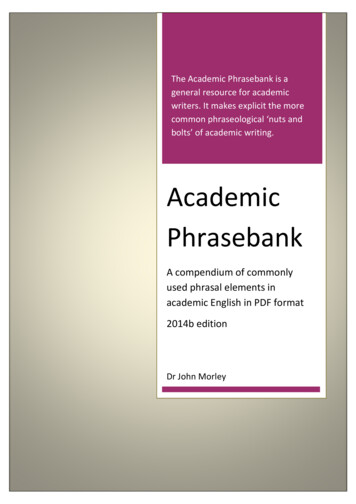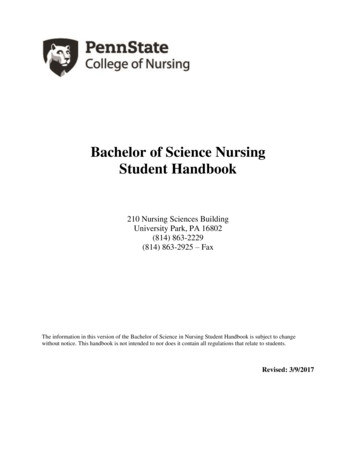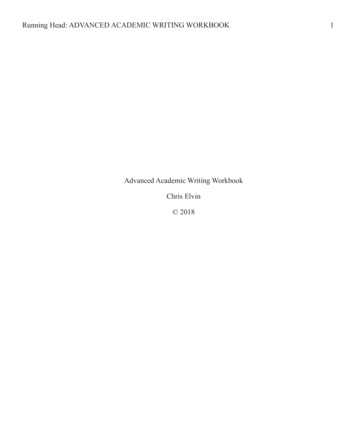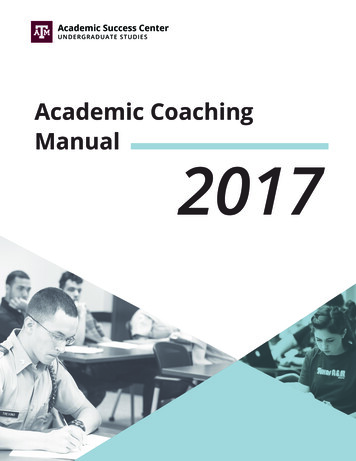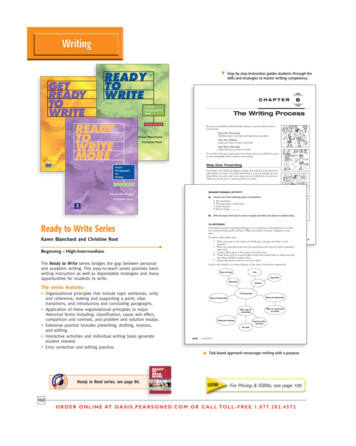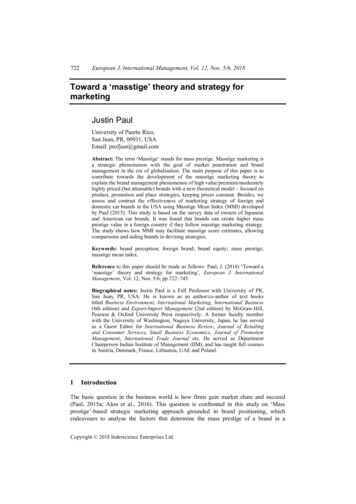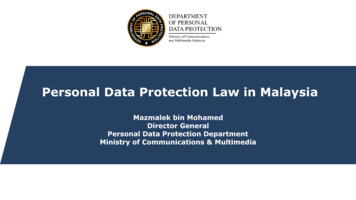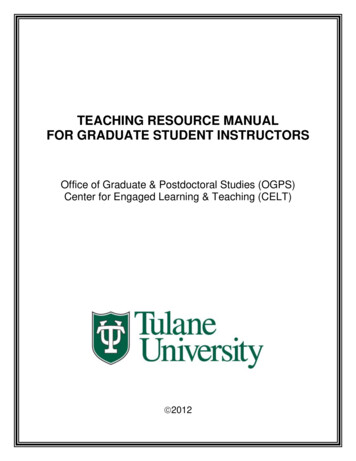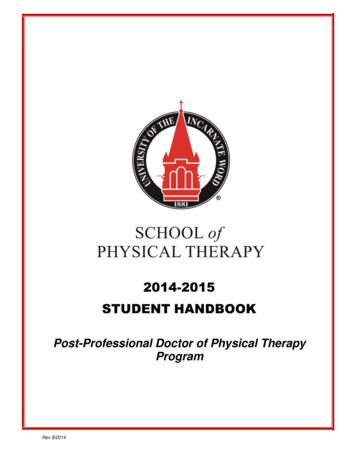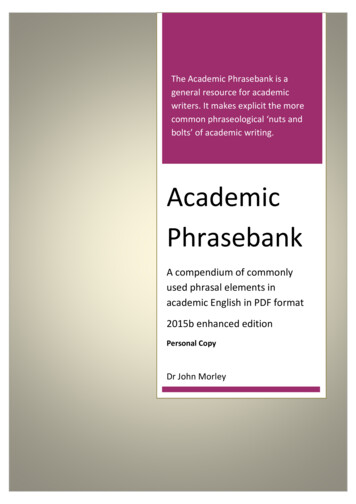
Transcription
The Academic Phrasebank is ageneral resource for academicwriters. It makes explicit the morecommon phraseological ‘nuts andbolts’ of academic writing.AcademicPhrasebankA compendium of commonlyused phrasal elements inacademic English in PDF format2015b enhanced editionPersonal CopyDr John Morley
PDF Download version 2015 The University of Manchester1 Page
PrefaceThe Academic Phrasebank is a general resource for academic writers. It aims to provide thephraseological ‘nuts and bolts’ of academic writing organised according to the main sections of aresearch paper or dissertation. Other phrases are listed under the more general communicativefunctions of academic writing.The resource was designed primarily for academic and scientific writers who are non-native speakersof English. However, native writers may still find much of the material helpful. In fact, recent datasuggests that the majority of users are native speakers of English.The phrases, and the headings under which they are listed, can be used simply to assist you inthinking about the content and organisation of your own writing, or the phrases can be incorporatedinto your writing where this is appropriate. In most cases, a certain amount of creativity andadaptation will be necessary when a phrase is used.The Academic Phrasebank is not discipline specific. Nevertheless, it should be particularly useful forwriters who need to report their empirical studies. The phrases are content neutral and generic innature; in using them, therefore, you are not stealing other people's ideas and this does notconstitute plagiarism.Most of the phrases in this compendium have been organised according to the main sections of aresearch report. However, it is an over-simplification to associate the phrases only with the section inwhich they have been placed here. In reality, for example, many of phrases used for referring toother studies may be found throughout a research report.In the current PDF version, additional material, which is not phraseological, has been incorporated.These additional sections should be helpful to you as a writer.2 Page
ContentsAbout Academic Phrasebank . . .4 . . . . . . . . . . . .72638455158 . . . . . . . . . . . . . . . . . . . . . . . . . . . . .687882858892939599101104106 . . . . . . . . . . . . . . . . . . . . .110113115116117119121122Major SectionsIntroducing workReferring to literatureDescribing methodsReporting resultsDiscussing findingsWriting conclusionsGeneral FunctionsBeing criticalBeing cautiousClassifying and listingCompare and contrastDefining termsDescribing trendsDescribing quantitiesExplaining causalityGiving examples as supportSignalling transitionWriting about the pastWriting abstractsNotes on Academic WritingAcademic styleCommonly confused wordsBritish and US spellingPunctuationUsing articlesSentence structureParagraph structureHelpful tips for writers3 Page
About Academic PhrasebankTheoretical InfluencesThe Academic Phrasebank largely draws on an approach to analysing academic texts originallypioneered by John Swales in the 1980s. Utilising a genre analysis approach to identify rhetoricalpatterns in the introductions to research articles, Swales defined a ‘move’ as a section of text thatserves a specific communicative function (Swales, 1981,1990). This unit of rhetorical analysis is usedas one of the main organising sub-categories of the Academic Phrasebank. Swales not only identifiedcommonly-used moves in article introductions, but he was interested in showing the kind oflanguage which was used to achieve the communicative purpose of each move. Much of thislanguage was phraseological in nature.The resource also draws upon psycholinguistic insights into how language is learnt and produced. It isnow accepted that much of the language we use is phraseological; that it is acquired, stored andretrieved as pre-formulated constructions (Bolinger, 1976; Pawley and Syder, 1983). These insightsbegan to be supported empirically as computer technology permitted the identification of recurrentphraseological patterns in very large corpora of spoken and written English using specialisedsoftware (e.g. Sinclair, 1991). Phrasebank recognises that there is an important phraseologicaldimension to academic language and attempts to make examples of this explicit.Sources of the phrasesThe vast majority of phrases in this resource have been taken from authentic academic sources. Theoriginal corpus from which the phrases were ‘harvested’ consisted of 100 postgraduate dissertationscompleted at the University of Manchester. However, phrases from academic articles drawn from abroad spectrum of disciplines have also been, and continue to be, incorporated. In most cases, thephrases have been simplified and where necessary they have been ‘sifted’ from their particularisedacademic content. Where content words have been included for exemplificatory purposes, these aresubstitutions of the original words. In selecting a phrase for inclusion into the Academic Phrasebank,the following questions are asked: does it serve a useful communicative purpose in academic text?does it contain collocational and/or formulaic elements?are the content words (nouns, verbs, adjectives) generic in nature?does the combination ‘sound natural' to a native speaker or writer of English?When is it acceptable to reuse phrases in academic writing?In a recent study (Davis and Morley, 2015), 45 academics from two British universities were surveyedto determine whether reusing phrases was a legitimate activity for academic writers, and if so, whatkind of phrases could be reused. From the survey and later from in-depth interviews, the followingcharacteristics for acceptability emerged. A reused phrase: should not have a unique or original construction;should not express a clear point of view of another writer;depending on the phrase, may be up to nine words in length; beyond this 'acceptability'declines;may contain up to four generic content words (nouns, verbs or adjectives which are notbound to a specific topic).Some of the entries in the Academic Phrasebank, contain specific content words which have beenincluded for illustrative purposes. These words should be substituted when the phrases are used. Inthe phrases below, for example, the content words in bold should be substituted:4 Page
X is a major public health problem, and the cause of .X is the leading cause of death in western-industrialised countries.The many thousands of disciplinary-specific phrases which can be found in academic communicationcomprise a separate category of phrases. These tend to be shorter than the generic phrases listed inAcademic Phrasebank, and typically consist of noun phrases or combinations of these. Acceptabilityfor reusing these is determined by the extent to which they are used and understood by members ofa particular academic community.Further workDevelopment of the website content is ongoing. In addition, research is currently being carried outon the ways in which experienced and less-experienced writers make use of the AcademicPhrasebank. Another project is seeking to find out more about ways in which teachers of English foracademic purposes make use of this resource.References Bolinger, D. (1976) ‘Meaning and memory’. Forum Linguisticum, 1, pp. 1–14.Davis, M., and Morley, J. (2015) ‘Phrasal intertextuality: The responses of academics fromdifferent disciplines to students’ re-use of phrases’. Journal Second Language Writing 28 (2)pp. 20-35.Hopkins, A. and Dudley-Evans, A. (1988). ‘A genre-based investigations of the discussionssections in articles and dissertation’. English for Specific Purposes, 7(2), 113-122.Pawley, A. and Syder, F.H. (1983). ‘Two puzzles for linguistic theory: nativelike selection andnativelike fluency’. In: Richards, J.C. and Schmidt, R.W. (Eds.), Language and Communication,pp. 191-226. Longman: New York.Sinclair, J. (1991) Corpus, concordance, collocation. Oxford: Oxford University Press.Swales, J. (1981). Aspects of article introductions (Aston ESP Research Report No. 1).Birmingham: Language Studies Unit: University of Aston.Swales, J. (1990). Genre analysis: English in academic and research settings. Cambridge:Cambridge University Press.5 Page
Major sections6 Page
Writing IntroductionsThere are many ways to introduce an academic essay or short paper. Most academic writers,however, appear to do one or more of the following in their introductions: establish the context, background and/or importance of the topicindicate an issue, problem, or controversy in the field of studydefine the topic or key termsstate the purpose of the essay or piece of writingprovide an overview of the coverage and/or structure of the writingIn very short assignments, it is not uncommon for a writer to commence simply by stating thepurpose of their writing.Introductions to research dissertations tend to be relatively short but quite complex in terms oftheir functional elements. Some of the more common elements or include: establishing the context, background and/or importance of the topicgiving a brief synopsis of the relevant literaturehighlighting the inadequacy of previous researchindicating a problem, controversy or a knowledge gap in the field of studyestablishing the desirability of the researchlisting the research questions or hypothesesproviding a synopsis of the research method(s)explaining the significance or value of the studydefining certain key termsproviding an overview of the dissertation or report structureexplaining reasons for the writer's personal interest in the topicExamples of phrases which are commonly employed to realise these functions are listed on thefollowing pages. Note that there may be a certain amount of overlap between some of thecategories under which the phrases are listed. Also, the order in which the different categories ofphrases are shown reflects a typical order but this is far from fixed or rigid, and not all the elementsare present in all introductions.A number of analysts have identified common patterns in the introductions of research articles.One of the best known is the CARS model (create a research space) first described by John Swales(1990)1. This model, which utilises an ecological metaphor, has, in its simplest form, three elementsor moves: 1Establishing the territory (establishing importance of the topic, reviewing previous work)Identifying a niche (indicating a gap in knowledge)Occupying the niche (listing purpose of new research, listing questions, stating value,indicating structure of writing)Swales, J. (1990) Genre Analysis, Cambridge: Cambridge University Press.7 Page
Establishing the importance of the topic for the disciplineA key aspect of X is X is of interest because X is a classic problem in A primary concern of X is X is a dominant feature of X is a fundamental property of The concepts of X and Y are central to X is at the heart of our understanding of Investigating X is a continuing concern within X is a major area of interest within the field of X has been studied by many researchers using X has been an object of research since the 1960s.X has been the subject of many classic studies in X has been instrumental in our understanding of The theory of X provides a useful account of how X has been an important concept in the study of the Central to the entire discipline of X is the concept of X is an increasingly important area in applied linguistics.X has been the subject of much systematic investigation.The issue of X has received considerable critical attention.Understanding the complexity of an X is vitally important if X has long been a question of great interest in a wide range of fields.One of the most significant current discussions in legal and moral philosophy is The discovery of X in 1986 triggered a huge amount of innovative scientific inquiry.The role of X in Y has received increased attention across a number of disciplines in recent years.Establishing the importance of the topic for the world or societyX is fundamental to X has a pivotal role in X is an important aspect of X is frequently prescribed for X is fast becoming a key instrument in .X plays a vital role in the metabolism of X is the most widely distributed species of X plays a critical role in the maintenance of Xs have emerged as powerful platforms for X is essential for a wide range of technologies.X can play an important role in addressing the issue of Xs are the most potent anti-inflammatory agents known.There is evidence that X plays a crucial role in regulating X is a common condition which has considerable impact on In the new global economy, X has become a central issue for .Determining the impacts of X on Y is important for the future of Evidence suggests that X is among the most important factors for X is important for a wide range of scientific and industrial processes.Xs are one of the most widely used groups of antibacterial agents and There is a growing body of literature that recognises the importance of X is an important component in the climate system, and plays a key role in Y.Xs were the most serious and widespread popular disturbances to occur in In the history of development economics, X has been thought of as a key factor in 8 Page
Establishing the importance of the topic (time frame given)Recently, there has been renewed interest in Traditionally, Xs have subscribed to the belief that One of the most important events of the 1970s was In recent years, there has been an increasing interest in Recent developments in X have heightened the need for The last two decades have seen a growing trend towards Recently, researchers have shown an increased interest in .Over the past century, there has been a dramatic increase in Recent trends in X have led to a proliferation of studies that .X proved an important literary genre in the early Y community.The past decade has seen the rapid development of X in many Recently, a considerable literature has grown up around the theme of Recent developments in the field of X have led to a renewed interest in Since it was reported in 2009, X has been attracting considerable interest.The past thirty years have seen increasingly rapid advances in the field of The changes experienced by X over the past decade remain unprecedented.In the last few decades, there has been a surge of interest in the effects of The study of X, which includes Y, has grown significantly since the early 1980s.For more than a century, scientists have been interested in the existence of In light of recent events in X, it is becoming extremely difficult to ignore the existence of Highlighting an important problemX is a leading cause of One of the main obstacles One of the greatest challenges A key issue is the safe disposal of The main disadvantage of X is that X is associated with increased risk of X is a common disorder characterised by It is now well established that X can impair X is a common, chronic disease of childhood.X has led to the decline in the population of X is a growing public health concern worldwide.The main challenge faced by many researchers is the X is one of the most frequently stated problems with Lack of X has existed as a health problem for many years.X is a major public health problem, and the main cause of Xs are one of the most rapidly declining groups of insects in .X is the leading cause of death in western-industrialised countries.Despite its long clinical success, X has a number of problems in use.Exposure to X has been shown to be related to adverse effects in There is increasing concern that some Xs are being disadvantaged There is an urgent need to address the safety problems caused by Questions have been raised about the safety of the prolonged use of The prevalence of X is increasing at an alarming rate in all age groups.Despite its safety and efficacy, X suffers from several major drawbacks:Along with this growth in X, however, there is increasing concern over X is increasingly recognised as a serious, worldwide public health concern.X and its consequences are an important, but understudied, cause for concern.9 Page
(However,)X may cause X is limited by X suffers from X is too expensive to be used for X has accentuated the problem of the performance of X is limited by X could be a contributing factor to the synthesis of X remains a major challenge.X can be extremely harmful to human beings.research has consistently shown that X lacks a major problem with this kind of application is the determination of X is technically challenging.current methods of X have proven to be unreliable.these rapid changes are having a serious effect on X can be adversely affected under certain conditions.accounting for these varying experiences is problematic .observations have indicated a serious decline in the population of Synopsis of literatureRecent evidence suggests that Previous studies have reported Recent studies have shown that Several studies have documented Studies of X show the importance of Several attempts have been made to Previous research has established that Data from several studies suggest that Recent work by historians has established that Previous research comparing X and Y has found Existing research recognises the critical role played by It is now well established from a variety of studies, that Recently investigators have examined the effects of X on Y.Surveys such as that conducted by Smith (1988) have shown that Factors found to be influencing X have been explored in several studies.A number of cross-sectional studies suggest an association between X and Y Studies over the past two decades have provided important information on A considerable amount of literature has been published on X. These studies In the past two decades, a number of researchers have sought to determine In previous studies of X, different variables have been found to be related to .The first serious discussions and analyses of X emerged during the 1970s with There have been a number of longitudinal studies involving X that have reported Xs were reported in the first studies of Y (e.g., Smith, 1977; Smith and Patel, 1977).What we know about X is largely based upon empirical studies that investigate how Smith (1984: 217) shows how, in the past, research into X was mainly concerned with Results from earlier studies demonstrate a strong and consistent association between There are a large number of published studies (e.g., Smith, 2001; Jones, 2005) that describe the linkbetween 10 P a g e
A number ofIt has beenWhatstudiesresearchershave found have reported have identified .have shown that have attempted to have demonstrated that have investigated whether have found an association between have explored risk factors associated with noted that argued that shown that reported that assumed that suggested that established that demonstrated that .conclusively shown that we know about Xis known about Xcomes fromis (largely) based onis (largely) derived fromaccounts by observations of laboratory studies.historical data from epidemiological studies.brief biographical details.cross-sectional studies of studies of people living in .case studies undertaken in contemporary textual sources.small-scale experiments with research using laboratory animals.research undertaken in major cities.a few primary sources from the time.studies conducted in populations of X.observations using various animal models.11 P a g e
Highlighting a controversy in the field of studyA much debated question is whether The precise effect of X is a much-debated topic.One major issue in early X research concerned .To date there has been little agreement on what .The issue has grown in importance in light of recent .There has been disagreement on the criteria for defining XIn the literature on X, the relative importance of Y is debated.One observer has already drawn attention to the paradox in .Questions have been raised about the use of animal subjects in .In many Xs, a debate is taking place between Ys and Zs concerning .Debate continues about the best strategies for the management of .There has been much division between historians on the subject of This concept has recently been challenged by X studies demonstrating .The debate about X has gained fresh prominence with many arguing that .More recently, literature has emerged that offers contradictory findings about .Scholars have long debated the impact of X on the creation and diffusion of One of the most significant current discussions in legal and moral philosophy is .The relationship between X and Y has attracted conflicting interpretations from One major theoretical issue that has dominated the field for many years concerns .The controversy about scientific evidence for X has raged unabated for over a century.The issue of X has been a controversial and much disputed subject within the field of .Several divergent accounts of X have been proposed, creating numerous controversies.The causes of X have been the subject of intense debate within the scientific community.In the literature on X, the relative importance of Y has been subject to considerable discussion.General reference to previous research or scholarship: highlighting paucity of researchThere is little published data on No previous study has investigated X .The use of X has not been investigated.There is very little published research on There has been no detailed investigation of There has been little quantitative analysis of .Data about the efficacy and safety of X are limited.Up to now, far too little attention has been paid to .A search of the literature revealed few studies which The impact of X on Y is understudied, particularly for So far, however, there has been little discussion about .In addition, no research has been found that surveyed .Surprisingly, the effects of X have not been closely examined.Surprisingly, X is seldom studied and it is unclear to what extent In contrast to X, there is much less information about effects of X has hitherto received scant attention by scholars of the Y period.A systematic understanding of how X contributes to Y is still lacking.Despite the importance of X, there remains a paucity of evidence on There have been no controlled studies which compare differences in .The issue of X has attracted very little attention from the scholarly community.To date, the problem of X has received scant attention in the research literature.To date, no large-scale studies have been performed to investigate the prevalence of .Although studies have recognised X, research has yet to systematically investigate the effect of 12 P a g e
To date,Surprisingly,There is aXhas (still) not (yet) (Very) few studies haveFew (published) studies .investigated.of studiesof well-controlled studiesinvestigating describing how that seek to identify predictors ofof empirical researchof high-quality researchin the field of focusing specifically on on the current prevalence of of scientific literatureof evidence-based literaturespecifically relating to on the experiences of describing the impact of explored focused on controlled for examined how compared trends in attempted to define examined the role of measured X in humans.quantified the levels of assessed the implications of evaluated the effects of X on examined the consequences of actually examined the impact of have systematically investigated provided quantitative evidence of systematically evaluated the use of attempted to quantify the impact of adequately tested the effectiveness of addressed the long term psychological effects of been large enough to provide reliable estimates of been conducted to determine the possible effects of 13 P a g e
AlthoughWhileWhilstSo far,To date,Up to now,some research has beencarried out on X,no single study exists which .no studies have been found which .no controlled studies have been reported.there is very little scientific understanding of .only two studies have attempted to investigate .the mechanism by which . has not been established.there have been few empirical investigations into .therehave been no attempts to examine has been very little research directly investigating X.have been very few empirically published accounts of X.very littleresearch has been carried out on has been published on the subject of attention has been paid to the role of X.fewstudies have examined the association between studies have investigated X in any systematic way randomised clinical trials have specifically investigated X in Highlighting inadequacies or weaknesses of previous studies (also refer to Being Critical)Previous studies of X have not dealt with .Researchers have not treated X in much detail.Such expositions are unsatisfactory because they .Such approaches, however, have failed to address Most studies in the field of X have only focused on .Previous published studies are limited to local surveys.Half of the studies evaluated failed to specify whether .The research to date has tended to focus on X rather than Y.Previously published studies on the effect of X are not consistent.Smith’s analysis does not take account of ., nor does she examine .The existing accounts fail to resolve the contradiction between X and Y.Most studies of X have only been carried out in a small number of areas.However, much of the research up to now has been descriptive in nature .The generalisability of much published research on this issue is problematic.Research on the subject has been mostly restricted to limited comparisons of .However, few writers have been able to draw on any systematic research into .Short-term studies such as these do not necessarily show subtle changes over time Although extensive research has been carried out on X, no single study exists which .However, these results were based upon data from over 30 years ago and it is unclear if .The experimental data are rather controversial, and there is no general agreement about .However, all the previous X research was cross-sectional in design. Therefore, it is unclear if Although there are many reports in the literature on the outcome of X, most are restricted to .Some evidence suggests that ., although further work using X is required to confirm this finding.14 P a g e
The existing literature on XMost of the work carried out on XNo previous study hasPrevious studies (of X)Most of these studiesfails to suffers from lacks clarity regarding ignores the possibility that has not distinguished between x and y in a systematic fashion.controlled for been large enough to completely eliminated distinguished between provided information on addressed the question of assessed the occurrence of .used a dynamic measure of given sufficient consideration to employed time-series techniques for utilised verbal reports to examine the problem of used a method for analysing multiple factors related to have suffered fromsmall sample sizes.low response rates.multiple design flaws.an overemphasis on inconsistent definitions.poorly developed theory.inadequate sample sizes.methodological limitations.serious sampling problems.poor case control matching.experimental design errors.inadequate research design.a lack of clarity in defining serious methodological flaws.a high degree of sampling bias.lack of instrumental sensitivity.considerable design limitations.the use of poorly matched controls.a paucity of standardised measures.notable methodological weaknesses.fundamental flaws in research design.lack of a strong theoretical framework.an over-reliance on self-report methodology.a restricted range of methodological approaches.shortcomings in the methods used to select cases.a lack of well-grounded theoretical considerations.several conceptual and methodological weaknesses.15 P a g e
Previous studies (of X)Most of these studiesPrevious studiesPrevious studiesonly involved only been carried out in only been undertaken using only provided weak evidence for havehave failed tohave failed tobeen of poor quality.been limited in a number of ways.been limited to convenience samples.been limited to a small number of cases assess measure adjust for control for investigate take account of separate the effects of address the question of identify a means by which build a definitive model of examine the role played by clearly differentiate between give sufficient consideration to consider X as a possible driving factor of .considerthe impact of the reas
phraseological ‘nuts and bolts’ of academic writing organised according to the main sections of a research paper or dissertation. Other phrases are listed under the more general communicative functions of academic writing. The resource was designed primarily for academic and s
